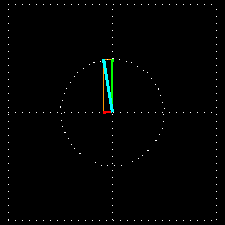
The following animation shows what happens when the two waves shown on the previous page are added with a phase difference of -90 degrees instead of 90 degrees. This requires shifting of one wave relative to the other one along their axis so that there is a 3/4 wavelength difference between them.

When the intersecting plane is looked at from the front then the following image is seen:

(Attention! The two animations are not synchronized!)
As you can see, again a circularly polarized light results but the electric field vector of this light rotates counterclockwise, rather than clockwise, when looked at from the direction of propagation. If you compare the spiral line representing the wave with the spiral line on the previous page, you will observe that one of them is a left-handed spiral and the other one is a right-handed one.
Based on this, we can distinguish right and left circularly polarized lights.